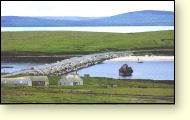 |
|
Location: St. Ola, Kirkwall, Orkney KW15 1SE
Roads: A964
Hours: Please telephone for information about visits
Phone: 01856-872071
|
Beneath the waters of Scapa Flow still lie the hulks of the German war fleet from World War I, scuttled on the orders of von Reuter who was fed up with the slowness of the post-war repatriation negotiations. During World War II, convoys gathered here for escorting across the Atlantic and Scapa distillery was used as accommodation for naval ratings.
The distillery was opened in 1885 and embarked on a century of production involving few changes of ownership. It was silent for two years from 1934 and was owned for a time by the owners of Glen Scotia distillery in Campbeltown. Scapa was rebuilt in 1959 with further internal improvements made in 1978.
The water supply carries a considerable amount of peat from the Lingro Burn and local springs, as a result of which the barley it uses is left unpeated. The waterwheel that supplied power to the original distillery is still there but the maltings were taken out of use in the 1960s not long after the rebuilding of the distillery.

One of the Churchill Barriers, linking the islands around Scapa Flow in the Orkneys.
|
The distillery has a single pair of stills, which date from 1978 and one of them is of the Lomond type, a rare feature. It has a short, stubby top instead of the elongated conical heads customary in Scottish distilleries. An appealing aspect for hard-line traditionalists is that the whisky is made without the usual hi-tec automation. The distillate intended for bottling as a single malt is aged exclusively in ex-Bourbon casks - which is oakwood charred on the inside of the staves.
The Whisky
Scapa is delicate, floral, salty and smooth textured. Elegant with slow-slide finish. It is bottles at 10 years, and 43% vol., although some 1979 was recently available.
Source of water
Lingro Burn
Of interest
>

One of the Churchill Barriers, linking the islands around Scapa Flow in the Orkneys.
|
• The Churchill Barriers are causeways built during World War II to link certain of the confetti of islands and keep out marauding German submarines.